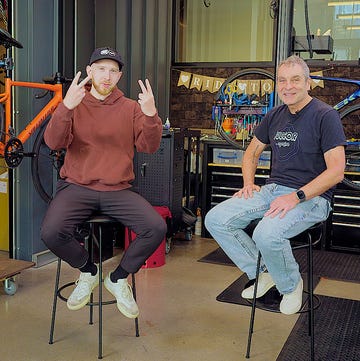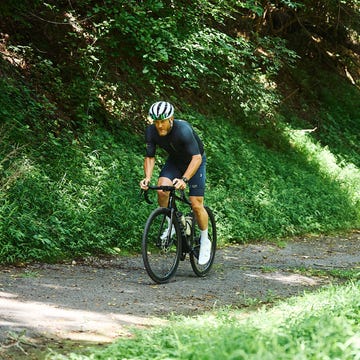Recently, I rode and reviewed Canyon’s latest Endurace road bike. Like most mid to high-end drop-bar bikes Bicycling takes in for review these days—from brands big and small—this bike had integrated, or internal, routing from the shift/brake lever to the brake calipers and derailleurs.
Admittedly, integrated bikes look sleek and clean, and there are aerodynamic benefits—albeit small—to hidden routing, too. But they also introduce a new level of complication and expense, which almost always falls on the user.
Every Endurace CFR and CF SLX comes from the factory with Canyon’s CP0018 integrated cockpit. This cockpit debuted with Canyon’s Aeroad redesign that dropped in 2020 and is also used on the latest generation of Ultimate.
This three-piece system has removable hooks, with the side benefit of adjustable bar width. It also offers 15mm of stem height adjustment with no fork-steerer cutting necessary.
Adjustment is cool! Options are great!
The one thing that is not adjustable is stem length. Every Endurace comes with a specified stem length which varies with frame size. This is not unique: Every bike outside of full custom has a stock stem length. Where things get messy for the Endurace, and every production bike with an integrated front end, is if a rider needs a different stem length.
And it’s double tricky for bikes with fixed-width bars: Essentially every bike but Canyons with the CP0018 cockpit.
Bike fit is super important to a rider’s comfort and performance. And how a bike fits is greatly influenced by stem length, with a secondary (and significant) influence on how a bike handles. Bar width affects a rider’s comfort and also breathing, aerodynamics, and how reactive a bike is to rider inputs.
These are not trivial matters: They’re fundamental to riders’ performance and enjoyment on the bike. It is not the same as buying an off-the-rack suit or dress that doesn’t fit quite right.
Canyon does not offer buyers a way to pick a different stem length at checkout. The bike comes as it comes. In theory, you could swap the stock CP0018 stem unit—you keep the hooks—for a different length. But Canyon, thus far, does not offer the CP0018 stem for sale on its website.
Although not stated in writing anywhere, a representative from Canyon USA informed me that riders in this country could reach out to Canyon’s office in Carlsbad, California, and arrange the purchase of a different stem for $300. Other countries are a different story, however.
Securing a stem is the easy part. But then you gotta swap the damn thing out.
Which isn’t easy because of the internal routing through the bars and stem. You’ll need to (at least) disconnect the hydraulic brake hoses and snake them out of the bars and stem. Then, rerun the hoses through the new stem, back through the bar hooks, and reconnect the hydraulic lines. And that’s a best-case scenario—leaving out potential hiccoughs like cutting off the hose barb and compression olive, bleeding the brakes, and re-wrapping the bars.
While some could do this swap at home, many don’t have the tools or experience, so they’d need to go to a shop for help. The bike shop I work with in my town charges $100 an hour for labor, and they estimate at least two hours for this swap. So, a rider is out $500—maybe more, maybe less—to change out the stem.
That’s a hell of a hit to make a bike fit properly.
This is on my mind because the stock 90mm stem on my Endurace test bike was twenty millimeters too short. This wasn’t a surprise: based on the geometry table, I knew the stock stem was too short before I took delivery of the bike. But since I got a stock bike from inventory and Canyon does not (yet) offer a way for riders to specify a stem length at purchase, I got a bicycle I knew would not fit properly.
I requested a 110mm stem while arranging my review sample, but, at the time, none were in stock. So I’ve been riding the bike way too short. And because of Canyon’s proprietary system, I have no avenue to fix the fit until Canyon can get me a stem (I’m told one is on the way).
The same thing happened to my colleague Dan Chabanov when he received Canyon’s new Ultimate for review. He tells me it took nearly four months—again, due to inventory issues—before he took delivery of the length he needed to realize his preferred fit.
As a practical matter for Dan and me, not having our preferred fit makes reviewing a bike difficult. Evaluating it is more challenging because it affects our comfort and throws off the bike’s handling. It also makes analyzing brands’ claims about a bike more difficult and disrupts our ability to benchmark and compare it to other bikes.
And as a personal matter, it’s flat-out annoying because the bike doesn’t feel right, which makes enjoying rides more difficult.
Those practical and personal matters don’t start and end with test editors: They’re also true for everyone spending their money on a beautiful new bicycle with an integrated front end.
Brands that go the integrated route must offer a higher level of service and the option to fine-tune fit—and have crucial components readily available in various dimensions—so riders can get the fit they need without fuss, outrageous expense, or prolonged downtime.
Ritte, for example, sells its Esprit race bike directly to consumers and offers buyers several stem length and bar width options (and other customization options) at checkout. The bike arrives at a rider’s door with their preferred cockpit dimensions—That’s the right way.
Factor is another brand offering customers the ability to fine-tune cockpit and other parts dimensions at checkout. Fezzari offers many customization options as part of its “23-point custom setup” scheme.
But many brands don’t like offering this level of service and options because it is more expensive for them. It also complicates things logistically.
To which I say, “Too fuckin’ bad.”
Cyclists are not monolithic. Bike brands are, by choice, making bikes less adaptable and harder to adjust and address riders’ unique fit needs. If brands want riders to buy their bikes with super integration, they must also offer the resources and services that let cyclists achieve their proper or preferred fit.
If Canyon were a brand that sold its products through an IBD (Independent Bicycle Dealer) network, I would be less twisted. At least with an IBD network, buyers would have a shop they could work with to dial in the fit, negotiate parts sourcing, and make any swaps as part of the sale.
I checked in with Specialized to see how it handles potential swaps of its integrated cockpit on the new S-Works Tarmac SL8.
A Specialized media relations representative told me, “Cockpits ship within the bike box in their aftermarket box. They are not assembled on the bike with hoses routed, etc. The idea is to make it easier for riders or shops to swap sizes if needed.
The rep continued, “Some markets offer size-specific white-glove delivery and assembly for direct-to-rider orders. In other instances, it’ll be up to the bike shop or the rider to handle swapping of the cockpit if a size change is needed. Since the cockpit ships with S-Works bikes in a full aftermarket package, it’s much easier for a shop to handle the swap since the cockpit will be like new.”
I checked in with an employee at the Specialized dealer in my town to ask how they would address a customer’s request to switch out the stock integrated cockpit on the new S-Works Tarmac SL8. He told me they would not one-for-one “trade” the stock cockpit for the new one. He explained that the shop used to make stem and bar length trades, but they wound up with a pile of take-offs they couldn’t sell.
They told me the customer would need to pay full price for the new Roval Rapide cockpit ($600). However, since the stock-sized cockpit was not installed, they do not charge additional labor to build the bike with the new cockpit.
I asked how they would react if the customer demanded, as a condition of the sale, that the swap be made gratis, as I don’t think it’s unreasonable that a customer might expect a $14,000 bike to fit right.
The shop told me they’d refuse and let the customer walk. Even though it’s a $14,000 bike, they noted that Specialized doesn’t offer enough margin on the S-Works Tarmac for them to absorb the parts required to make the swap.
Frankly, I’m disappointed that Specialized doesn’t do more to support its dealers and encourage them to personalize bike fit. The brand trumpets its “Beyond Gender” approach to bike fit with statements like, “Our bikes give you an excellent ride, right out of the box. But we make your bike yours through personalization. With the support of our retail network and Retül, we go the extra mile to ensure that you get the best possible service, performance benefit, and comfort”.
Trek offers many customization options if you buy a bike through its Project One program. Any of its SLR road models—Madone, Emonda, Domane—and “Project One customization [is] built into the price, which means that if you wanted to customize a component size, there is no upcharge to make that change when you initially order the bike,” said Trek’s road product director, Jordan Roessingh.
Buy a lower-level Trek model, and you’ll need to negotiate parts swaps with the dealer.
I also investigated Competitive Cyclist’s policy on parts swaps. Pretending to be a regular customer shopping for a Cervélo S5, I connected with one of their “Gearheads” via the site’s chat tool. I asked how much they charge to swap out the stock bar width and stem length on a 54cm bike for ones with different dimensions.
The representative stated, “We would have you purchase the new bar and stem, and we could install them on the bike. But we would still have to ship out the original bar and stem due to our vendor agreements with Cervelo.”
Competitive sells the S5’s stem for $300, while the bar sells for $400. That’s another $700 (on top of the $9,000 or more a rider already spent).
I asked if there were additional labor charges for installing the new bar and stem, and they responded, “Nope.” Phew.
The representative further confirmed that this is the policy for all of Competitive’s bike sales, “Unless it says, ‘Exclusive Bike,’ then that would be open to full customization.”
I also feel bad for the shop employees left to clean up the mess created by brands and their fascination with integration and proprietary parts.
Sure, their service departments (potentially) make more money because of the increased labor required to replace a handlebar or headset bearing. But I’ve spoken with these front-line employees, and they tell me that customers are often shocked and angry—and not shy about expressing their ire—at the increased expense and longer waits servicing these integrated systems require.
But ire or not, with the Trek, Specialized, Factor, Ritte, Fezzari, and even Competitive Cyclist examples above, there are dealers to work with, policies in place, or options available at checkout. With Canyon’s approach, the bike lands in the rider’s lap, and they’re largely left to deal with fit and adjustment independently.
And this is why I have mixed feelings about Canyon selling increasingly complex and integrated bicycles. Maybe Canyon’s killer pricing and (typically) superb performance are enough for riders to deal with the added headaches themselves.
Whether D to C or sold through an IBD, I’m increasingly frustrated with off-the-rack bikes becoming more expensive, harder to personalize and fit, and providing fewer parts options to the rider because they use non-standard and proprietary parts. Such parts have a habit of disappearing into the dustbin of history as brands move on to their next big idea.
What will happen to today’s Cervélo S5 customers in five or ten years if they need to replace a damaged handlebar or stem? I think I know, and it is not pretty.
I’m also left to wonder why I’d recommend riders spend five figures on a Specialized Tarmac, a Cannondale SuperSix Evo, or a Cervélo S5 and deal with the hassle and expense of fitting them when for about the same price they could buy the USA-Made Argonaut RM3—one of the finest road bikes I’ve ridden, ever—with custom-fit components and custom carbon layups included in the price.
While I understand the computer and wind tunnel time put into the Tarmac, SuperSix, and S5 to make them so light, stiff, and aerodynamic are expensive (and those costs need to be recouped), a handful of watts and grams saved are beyond worthless if a bike doesn’t fit and handle correctly.
Whether it’s Canyon, Specialized, or any other brand, I have a tough time with companies selling bikes that promise superb performance but shirking their responsibility to help riders achieve a proper fit. Which I feel confident declaring is the primary factor in a rider getting the most from their new bike and experiencing a comfortable, fast, and enjoyable ride.

A gear editor for his entire career, Matt’s journey to becoming a leading cycling tech journalist started in 1995, and he’s been at it ever since; likely riding more cycling equipment than anyone on the planet along the way. Previous to his time with Bicycling, Matt worked in bike shops as a service manager, mechanic, and sales person. Based in Durango, Colorado, he enjoys riding and testing any and all kinds of bikes, so you’re just as likely to see him on a road bike dressed in Lycra at a Tuesday night worlds ride as you are to find him dressed in a full face helmet and pads riding a bike park on an enduro bike. He doesn’t race often, but he’s game for anything; having entered road races, criteriums, trials competitions, dual slalom, downhill races, enduros, stage races, short track, time trials, and gran fondos. Next up on his to-do list: a multi day bikepacking trip, and an e-bike race.




















